Ever wonder how some bedrooms feel perfectly cozy yet effortlessly stylish? The secret often lies in the clever arrangement of space and thoughtful design choices—making bedroom layout design an incredibly popular way to transform a personal sanctuary into a haven of comfort and style. Whether you’re working with a compact space or a sprawling retreat, the right layout can dramatically boost both functionality and aesthetic appeal.
In this article, you’ll discover a treasure trove of inspiration and practical ideas to elevate your bedroom. From creating stunning focal points to maximizing storage and enhancing natural light, we’ll explore a variety of layout techniques that cater to different tastes and needs. Get ready to unlock the full potential of your bedroom with creative, easy-to-implement ideas that will make your space not just beautiful, but truly inviting.
A striking headboard instantly elevates your bedroom’s style and serves as the visual centerpiece that anchors the entire space. It’s a simple way to add personality, whether through bold textures, vibrant colors, or unique shapes, making your room feel thoughtfully designed and inviting.
Imagine a plush, upholstered headboard in deep emerald green, with tufted buttons adding texture and depth. Alternatively, a sleek, modern wooden headboard with geometric carvings or a vintage metal frame painted in matte black can create a dramatic statement. Surrounding the headboard with soft lighting or decorative pillows enhances its impact, making it both a visual and tactile focal point. The overall effect is a cozy yet sophisticated vibe that draws the eye the moment you enter the room.
To recreate this look, start by choosing a headboard that matches your style—upholstered fabric in a rich hue, a carved wood piece, or an industrial metal frame. Secure it firmly to the wall or bed frame. Complement it with layered bedding, like a textured duvet cover and decorative pillows, in coordinating colors for extra flair. You can add string lights or a small gallery of framed photos above for extra personality. This simple upgrade instantly transforms your bedroom into a stylish retreat.
1. Optimize Room Flow with Strategic Furniture Placement

Creating an easy-flowing, functional bedroom depends heavily on how you arrange your furniture. Proper placement not only maximizes space but also promotes a calm, uncluttered environment that invites relaxation and effortless movement.
Visualize a room where the bed is positioned against a central wall, leaving enough space on each side for bedside tables. Keep pathways clear from the door to the closet and windows—no furniture blocking these routes. Place larger pieces, like dressers or armoires, against walls to free up the middle of the room, and consider angling or floating furniture away from corners for a more open feel. Using a large area rug under the bed anchors the space visually and adds softness underfoot, making the room feel more inviting.
To implement this, measure your room and furniture before arranging. Position the bed to allow easy access from both sides, ideally with space for nightstands and lamps. Keep bulkier items like dressers along the longest walls to avoid overcrowding. Avoid placing furniture directly in front of windows to maximize natural light. With a thoughtful layout, your bedroom becomes a peaceful sanctuary where everything has its place, and movement feels natural.
2. Incorporate Multi-Functional Furniture for Space Efficiency

Multi-functional furniture is a game-changer for maximizing space, especially in smaller bedrooms. Items like beds with built-in storage, fold-away desks, or ottomans that double as seating and storage help keep clutter at bay while adding style and practicality.
Picture a bed with sleek, hidden drawers underneath for clothes or linens, or a bench at the foot of the bed that opens to store blankets and pillows. A fold-out desk tucked into a corner can double as a workspace during the day and a relaxing reading nook at night. Compact nightstands with shelves or drawers provide storage without taking up extra space, and wall-mounted shelves help keep surfaces clear. These pieces serve multiple purposes, making your room feel more spacious and organized.
To achieve this, choose furniture with built-in storage options—look for beds with drawers, storage ottomans, or wall-mounted desks. Use versatile pieces like fold-away or modular furniture to adapt to your needs. Keep clutter hidden and surfaces clear by selecting items that serve dual functions. These smart choices create a tidy, stylish bedroom that maximizes every inch of space while maintaining a cozy, functional atmosphere.
3. Use Zone Dividers to Define Different Areas
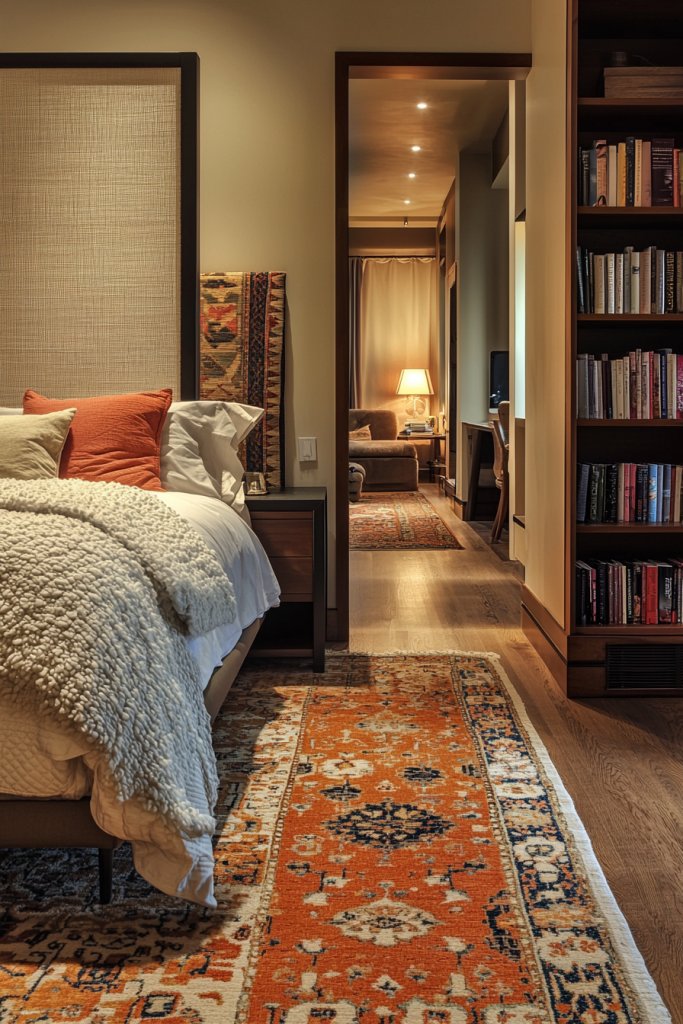
Dividing your bedroom into distinct zones can dramatically improve functionality and comfort, especially when space is limited. Using rugs, screens, or strategic furniture placement helps create visual separation between sleeping, dressing, and relaxing areas.
Imagine a plush, patterned rug under the bed that visually separates the sleep zone from the rest of the room. A lightweight folding screen or a series of open-backed bookshelves can serve as a subtle divider, providing privacy and defining space without closing it off entirely. Even a cozy armchair with a small side table can create a relaxing nook that feels separate from the bed. These zones make your bedroom more organized, inviting, and tailored to your daily routines.
To implement, start by choosing a focal point—perhaps the bed—and arrange furniture around it to create designated areas. Use different rugs or textiles to mark boundaries visually. Position screens or open shelving to block off areas as needed, ensuring pathways remain clear. With thoughtful zoning, your bedroom becomes a multi-functional retreat that supports both rest and activity, all while feeling spacious and harmonious.
4. Enhance Visual Balance with Symmetrical Arrangements
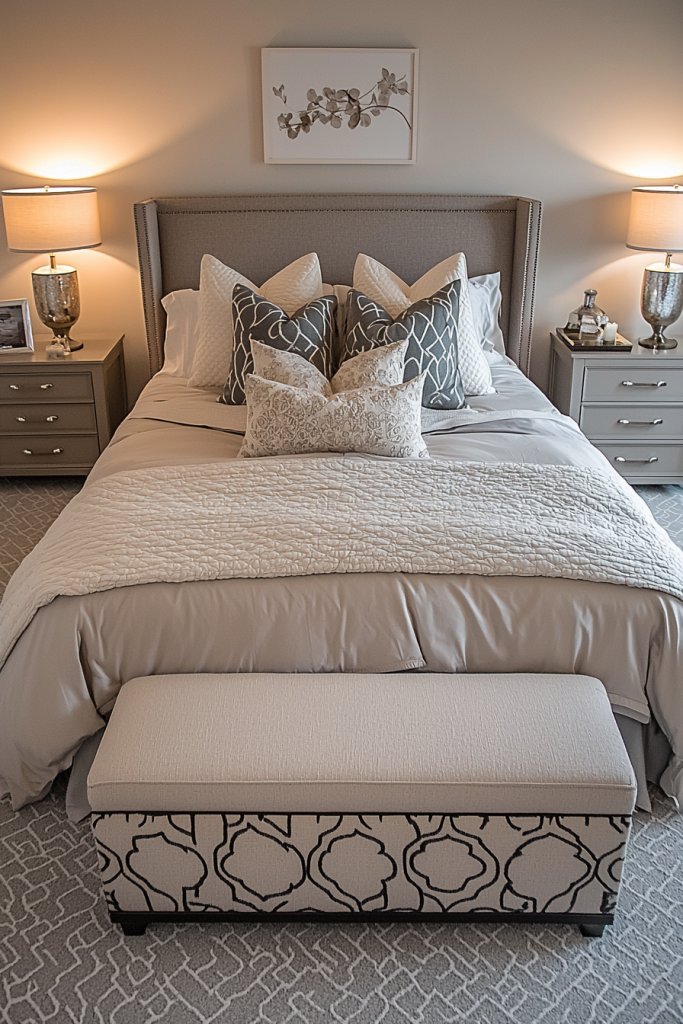
Achieving a sense of harmony and order in your bedroom often comes down to symmetry. Placing matching furniture and decor elements around your bed creates a balanced, calming atmosphere that feels intentionally curated and aesthetically pleasing.
Visualize two matching bedside tables flanking the bed, each topped with a similar lamp and decorative accessory. Symmetrical arrangements extend to artwork, where two framed photos or mirrors are hung at equal height on either side of the headboard. Using matching textiles, like pillows and throws, further reinforces the sense of balance. This approach not only looks polished but also provides a sense of stability and comfort that is pleasing to the eye.
To create this effect, select pairs of decor items—such as identical lamps, lampshades, or sculptures—and place them symmetrically. Arrange the furniture in a mirrored layout, paying attention to height and spacing for uniformity. Keep color schemes consistent across both sides to enhance cohesion. By thoughtfully balancing your decor, your bedroom exudes tranquility and refined style, making it a true sanctuary of comfort.
5. Choose a Cohesive Color Palette for Serenity and Style
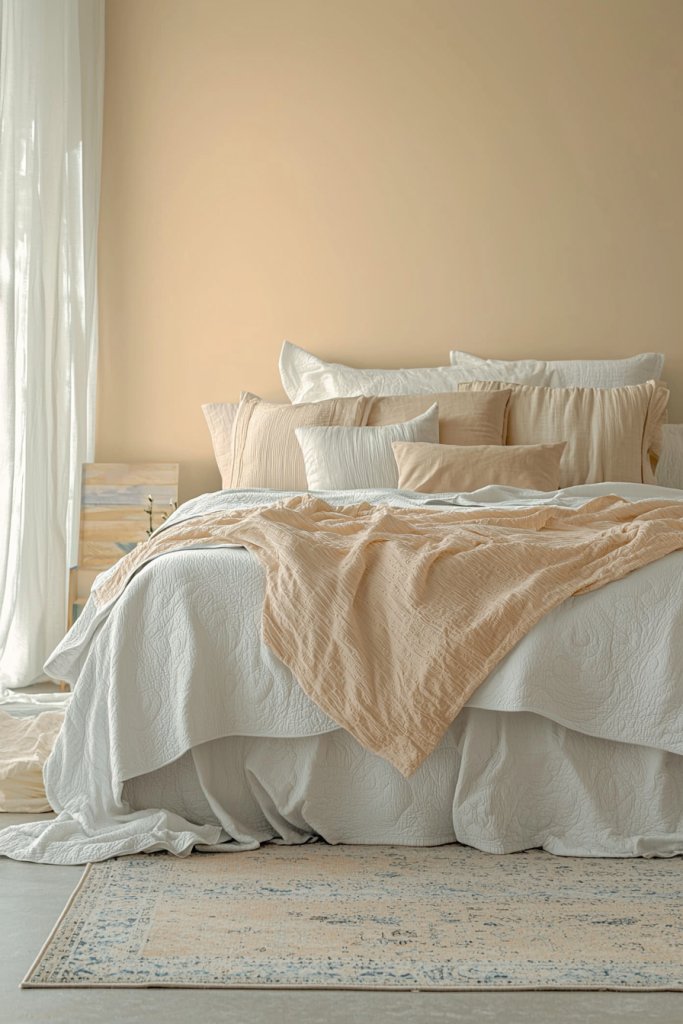
Selecting the right color palette is essential for creating a calming and stylish bedroom environment that feels harmonious and inviting. When colors work well together, they foster a sense of balance and tranquility, making your space a true retreat from daily stress. This idea matters because it sets the tone for the entire room, influencing mood and perceived spaciousness.
Imagine a soft, soothing color scheme featuring shades like warm beige, blush pink, cool taupe, or muted greys. Walls painted in a gentle, neutral hue form the perfect backdrop, while bedding and decor in coordinating pastel or earthy tones add subtle pops of color. Incorporate textures such as a plush velvet cushion or a linen bedspread to introduce depth, and use accent pieces like throw pillows or curtains to tie everything together. The overall effect is a serene, cohesive space that feels both fresh and cozy, with natural light highlighting the gentle color transitions. This palette creates an atmosphere of relaxation, making your bedroom more than just a place to sleep—it’s a sanctuary.
Start by choosing a main neutral color like soft cream or light grey for the walls. Then, pick 2-3 complementary shades for your bedding, pillows, and accessories—think dusty rose, sage green, or warm terracotta. Keep the colors consistent across textiles and decor to avoid visual clutter. To make it easy, opt for paint swatches or fabric samples before committing. Incorporate metallic accents, such as brushed gold or matte black, for added sophistication. By sticking to a cohesive palette, you’ll craft a visually soothing space that enhances comfort and style effortlessly.
6. Add Layered Lighting for Ambiance and Practicality
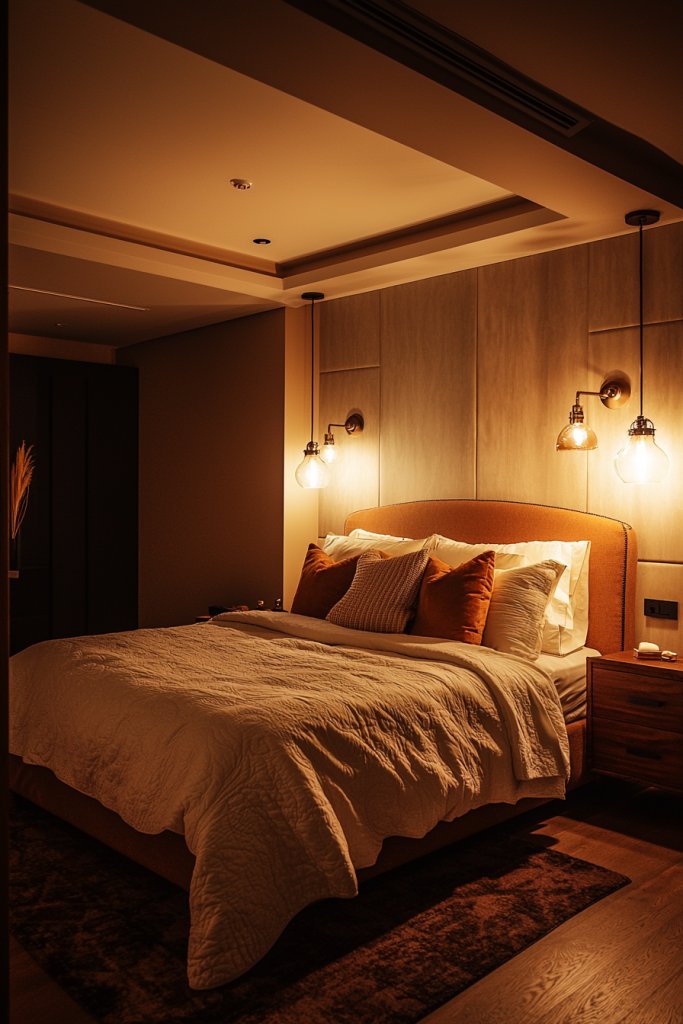
Layered lighting transforms your bedroom from a simple space into a cozy, functional sanctuary. Combining different types of lighting—ambient, task, and accent—ensures your room is both inviting and practical for various activities, from relaxing to reading or dressing. This approach matters because the right lighting can dramatically influence mood and usability, making your bedroom a truly versatile retreat.
Picture a warm, welcoming glow created by a combination of fixtures: a soft overhead pendant or recessed lights for general illumination, paired with warm bedside lamps that cast a gentle, adjustable light. Consider adding a pair of wall-mounted sconces or clip-on reading lights for focused tasks, and maybe a small, decorative lamp on a dresser for accent lighting. The textures of the lampshades—like linen or frosted glass—add visual interest, while dimmer switches allow you to adjust brightness for different times of day or moods. The overall effect is a layered, inviting atmosphere that feels both cozy and practical, perfect for winding down or energizing your mornings.
To set this up, start with a central overhead light or ceiling fixture as your main source. Add bedside table lamps with warm-toned bulbs for comfort and convenience—look for options with fabric shades or ceramic bases to enhance texture. Incorporate wall sconces or adjustable reading lights next to the bed for focused illumination. Use dimmer switches or smart lighting to control brightness levels easily. Keep the color temperature warm (around 2700K) for a relaxing vibe. By layering your lighting, your bedroom becomes a welcoming space that adapts seamlessly to your needs.
7. Maximize Storage with Built-In Solutions
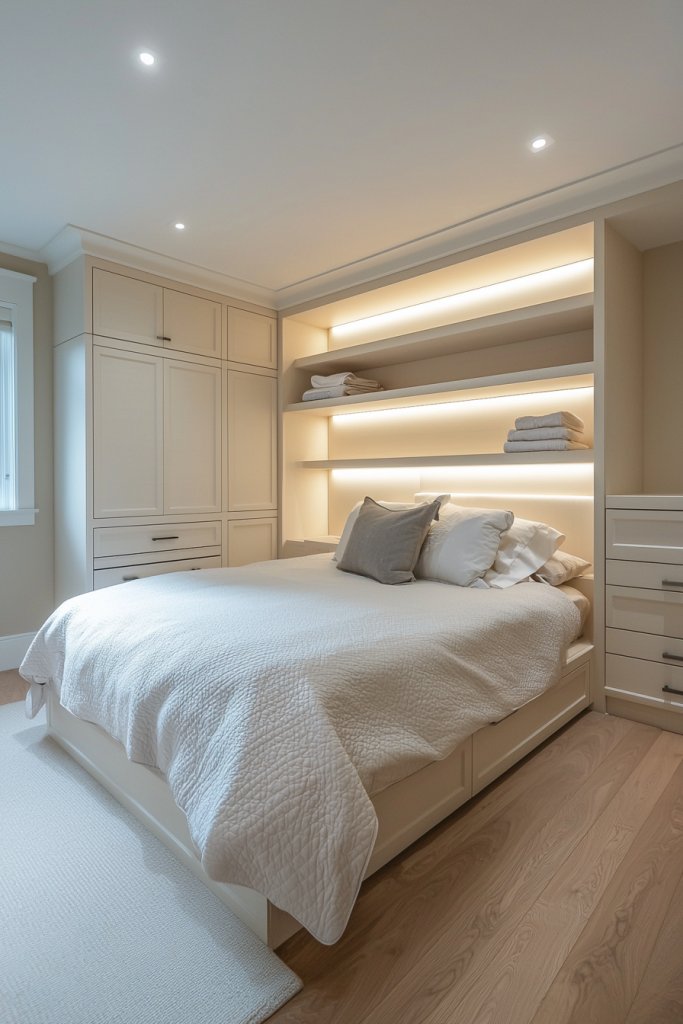
Built-in storage solutions are a game-changer for keeping your bedroom organized without sacrificing style or space. By seamlessly integrating shelves, cabinets, or drawers into the architecture, you can hide clutter and maintain a clean, spacious look. This idea is particularly valuable for small rooms or those with limited closet space, as it maximizes every inch efficiently.
Visualize sleek, wall-mounted shelves above the bed or along an empty wall, painted to match the room’s color palette for a seamless look. Under-bed drawers or a custom platform bed with integrated storage compartments help hide out-of-season clothing, shoes, or bedding. Wall-mounted cabinets or floating shelves can hold decorative objects, books, or everyday essentials, freeing up surface space. Use high-quality wood, MDF, or plywood for a sturdy finish, and consider soft-close mechanisms for durability. Incorporate baskets or fabric boxes for additional organization, and choose materials that complement your overall decor style—whether modern, rustic, or minimalist. These solutions keep your bedroom tidy while adding a polished, cohesive appearance.
Begin by measuring available space and choosing storage units that fit comfortably. Install wall-mounted shelves or cabinets at appropriate heights, ensuring they’re securely anchored into studs for safety. Opt for under-bed storage drawers or boxes with lids for easy access. For a DIY approach, use pre-made storage bins or fabric baskets that fit your aesthetic and budget. Keep clutter out of sight by labeling or color-coding storage containers. With these built-in and hidden solutions, your bedroom will feel spacious, organized, and stylish—ready for restful nights and functional mornings.
8. Incorporate Textiles for Comfort and Visual Appeal

Textiles are the finishing touch that adds warmth, softness, and personality to your bedroom layout. Layering different fabrics and textures creates visual interest while making the space feel cozy and inviting. This idea is vital because textiles can instantly elevate a room’s style and comfort level, making it more than just a functional space.
Imagine a plush, high-pile rug in a neutral tone under the bed, inviting you to sink your feet into its softness. Drape a chunky knit throw blanket across the foot of the bed, adding texture and warmth. Use silky or linen pillowcases in coordinating colors to enhance comfort and visual harmony. Incorporate decorative cushions with varied patterns and textures—like velvet, faux fur, or woven textiles—to create depth. Soft, layered bedding in a mix of matte and shiny fabrics adds tactile richness, while decorative throws and curtains in coordinating hues tie the look together. These textiles not only soften the room’s appearance but also engage your senses, making your bedroom a true retreat.
To recreate this, select a high-quality duvet or quilt with a cozy texture, such as a faux fur or chunky knit throw. Add plush pillows in complementary shades, mixing different fabrics for visual interest. Layer a soft area rug with a textured surface under or beside the bed. Choose window treatments like linen curtains or velvet drapes that coordinate with your color palette. Incorporate tactile accents like a velvet cushion or a faux fur throw for extra dimension. By thoughtfully combining textiles, you’ll craft a bedroom that’s both visually appealing and irresistibly comfortable.
9. Create a Cozy Nook with a Reading Corner
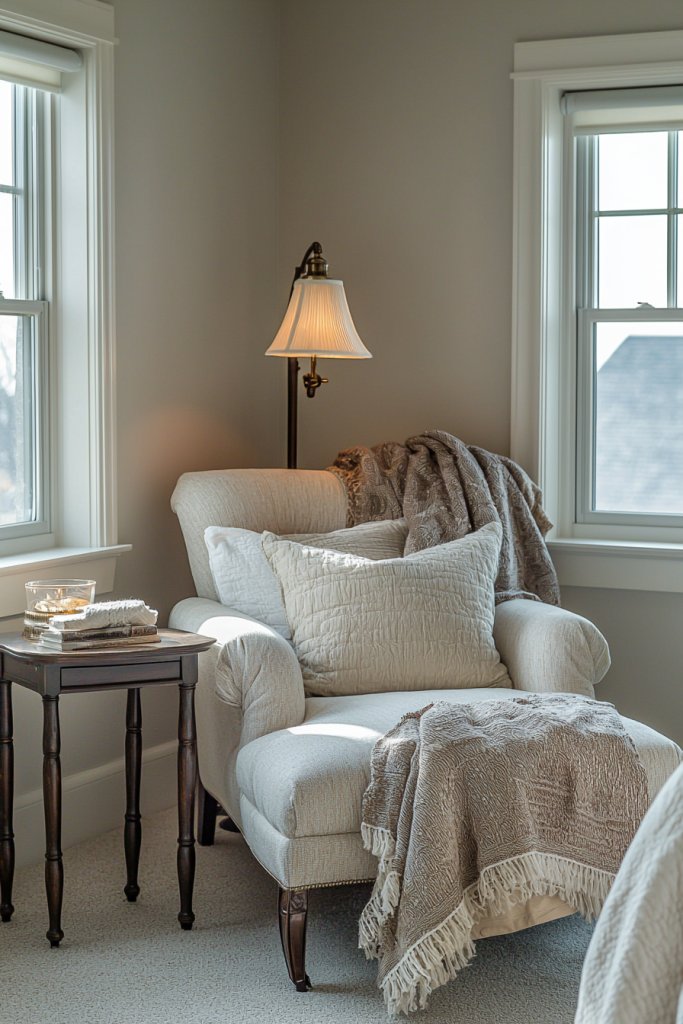
Designing a dedicated reading nook transforms a corner of your bedroom into a tranquil retreat within your home. This space offers a perfect spot to unwind, read, or relax without disturbing your sleeping area. It’s an ideal way to add personality and functionality to your bedroom layout, making it feel more personalized and inviting.
Visualize a small, comfortable armchair or a cozy accent chair in a soft fabric like linen or velvet, positioned near a window or in a quiet corner. Add a small side table in natural wood or ceramic to hold your favorite books, a cup of tea, or a reading lamp. Incorporate a plush throw blanket draped over the chair and a decorative cushion for extra comfort. Use a textured area rug underneath to define the space and add tactile warmth. Enhance the ambiance with soft lighting—perhaps a stylish floor lamp or a table lamp with a fabric shade—creating a perfect setting for relaxing moments. This nook becomes a charming, functional retreat that enhances your bedroom’s overall comfort.
To create your own, choose a comfortable, stylish chair suited to your space—think a mid-century armchair or a cushioned pouf. Place it near a window or in a corner that receives natural light. Add a small table or floating shelf nearby for books and accessories. Layer a cozy throw and decorative cushions to encourage lounging. Install soft lighting, like a standing lamp or a small table lamp, for a warm glow. Finish with a textured rug to anchor the space visually. This simple addition will make your bedroom a more versatile, welcoming sanctuary for relaxation and reading.
10. Use Mirrors to Enhance Space and Light
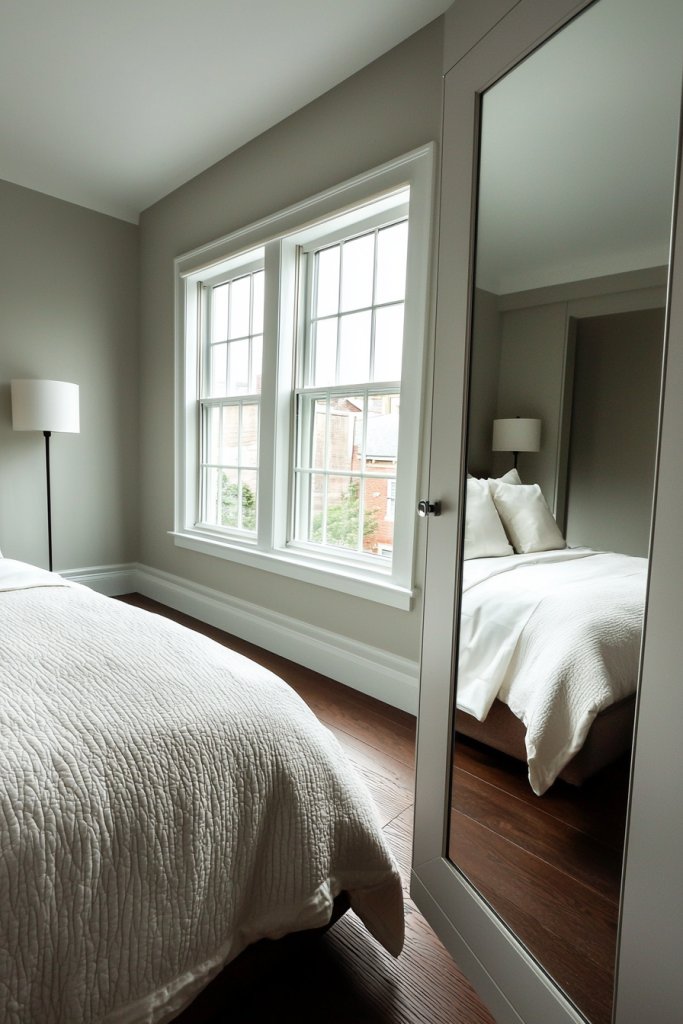
Mirrors are a simple yet powerful tool to make your bedroom feel larger, brighter, and more inviting. When placed thoughtfully, they reflect natural light from windows and bounce it around the room, creating an airy, luminous atmosphere that elevates the overall mood. This technique is especially useful in smaller spaces or rooms with limited natural sunlight, making the environment feel more open and fresh.
Imagine a sleek, frameless mirror mounted above a vintage dresser, its surface capturing the soft glow of a nearby bedside lamp. Alternatively, a large, full-length mirror leaning against a wall can serve as both a functional dressing aid and a visual extension of the room. The reflective surface can be framed in minimalist metal or painted wood to match your decor style, while strategically placing it across from a window maximizes light reflection. For added style, consider arranging multiple smaller mirrors in an interesting pattern to create a dynamic focal point.
To implement this idea, start by choosing a mirror size appropriate for your space—large enough to create impact but not overwhelming. Secure it safely to the wall using appropriate hardware, ensuring stability. If you prefer a portable option, an over-the-door mirror or leaner piece can be easily moved and adjusted. Pair the mirror with ambient lighting such as warm LED bulbs or fairy lights to enhance its reflective qualities and add a cozy glow. This simple upgrade can dramatically transform your bedroom’s atmosphere with minimal effort.
11. Highlight Architectural Features with Accent Wall Designs
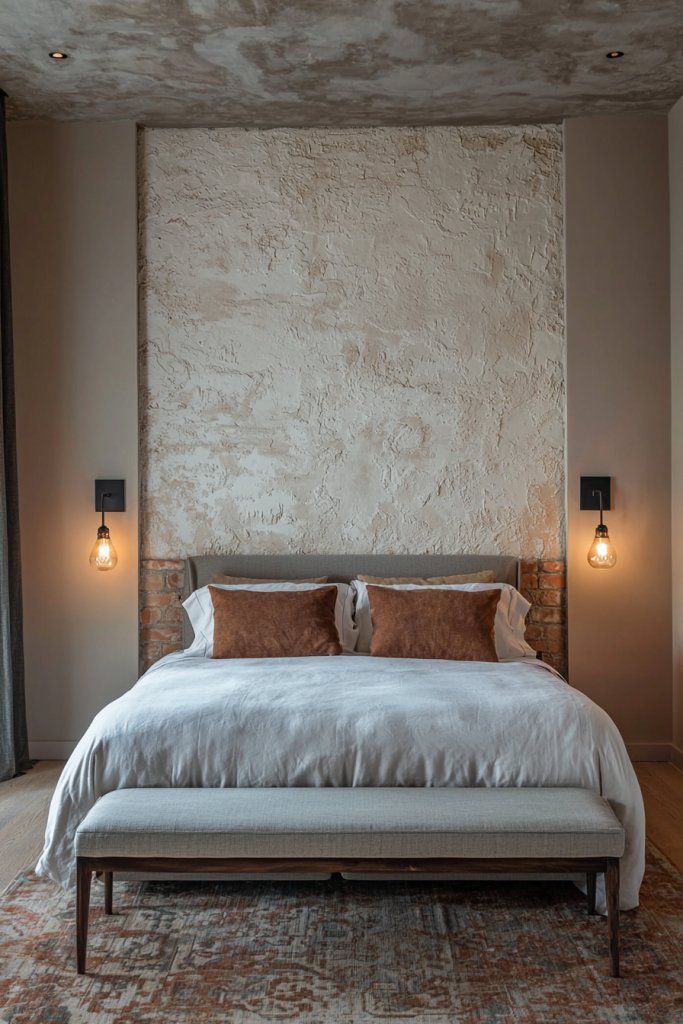
Accent walls are a fantastic way to emphasize your bedroom’s unique architectural elements or add depth and personality to the space. Whether it’s a textured plaster surface, exposed brick, or a bold painted statement, this technique draws the eye and creates a captivating focal point that anchors the room’s design.
Picture a wall behind the headboard painted in a deep navy blue, textured with a subtle brushstroke effect, while the other walls remain a soft neutral. Or imagine a section covered in elegant wallpaper with a metallic or geometric pattern that catches the light and adds visual interest. For a more tactile experience, a wall with textured panels, wood slats, or shiplap can bring warmth and dimension, turning a plain wall into a statement feature. The goal is to select a design that complements your overall color palette and style, whether modern, rustic, or bohemian.
To achieve this look, start by selecting your accent wall area—typically behind the bed or a key feature wall. Prepare the surface by cleaning and priming it if necessary. Choose your material: paint, wallpaper, textured panels, or reclaimed wood are popular options. Use painter’s tape or guides for clean lines if painting, or carefully align wallpaper seams. Incorporate lighting such as wall sconces or picture lights to highlight the feature and add ambiance. This approach not only enhances the room’s aesthetic but also gives it a personalized, designer touch with relatively straightforward DIY or professional help.
12. Incorporate Decorative Accessories for Personal Touches
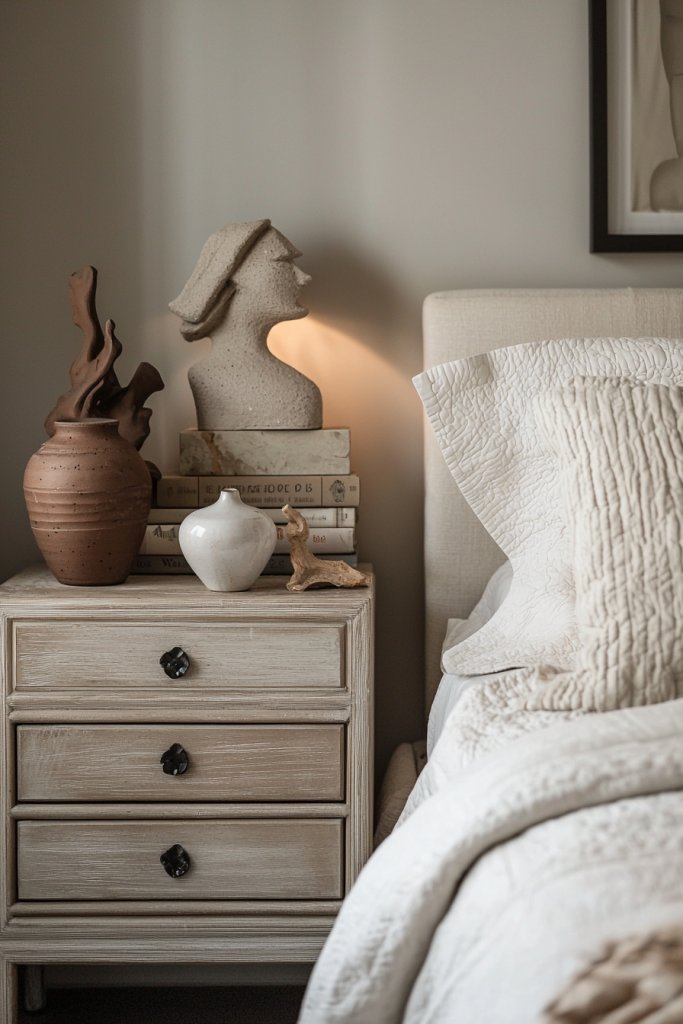
Adding decorative accessories elevates your bedroom from a simple space into a reflection of your personality and style. Thoughtfully selected objects like sculptures, ceramics, vintage finds, or meaningful souvenirs bring character, texture, and visual interest, transforming an ordinary layout into a curated retreat.
Visualize a collection of ceramic vases in soft matte finishes arranged on a bedside table, or a sculptural sculpture placed on a dresser that catches the eye. Incorporate decorative objects in varied materials—marble, wood, metal, or glass—to create contrast and richness. For example, a cozy bedside nook might include a stack of vintage books topped with a small ceramic figurine, while a corner shelf displays a mix of decorative bowls, candles, and framed photos. These accessories should complement your color palette and overall aesthetic, adding layers of depth and personality.
To incorporate these touches, start by selecting a few meaningful or visually appealing items that resonate with your style. Place larger pieces where they can be focal points, such as on dressers or shelves, and use smaller accessories to add detail on nightstands or windowsills. Mix textures and shapes to keep it interesting, but avoid clutter by choosing a curated selection. These accessories can be swapped out seasonally or as your style evolves, making your bedroom a dynamic, personalized sanctuary that feels uniquely yours.
13. Implement a Minimalist Approach for a Calm Environment
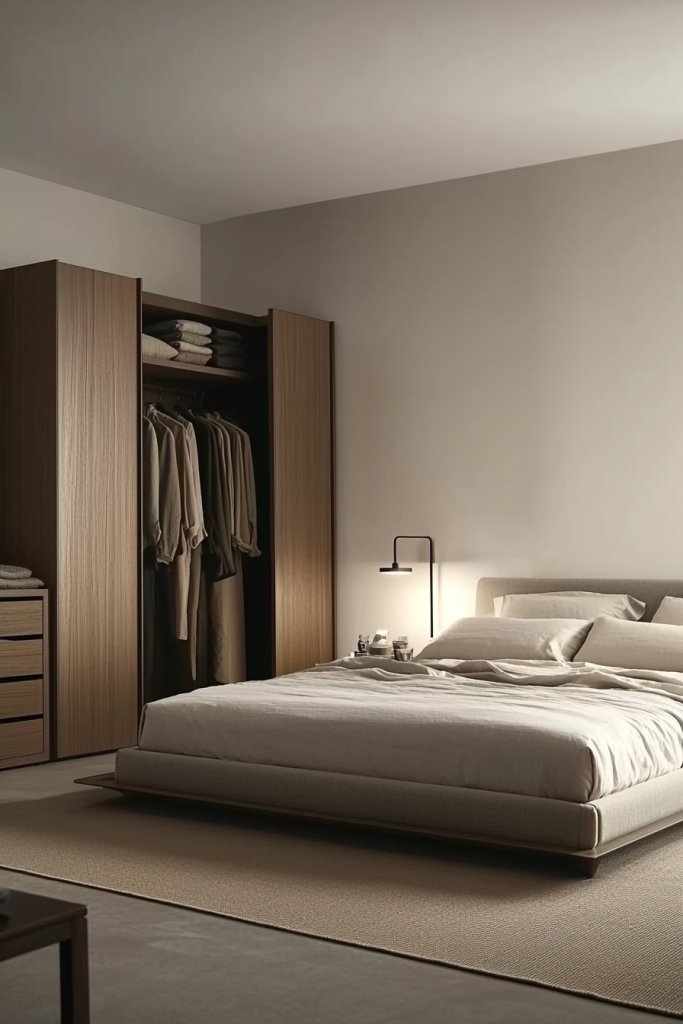
A minimalist bedroom emphasizes simplicity and order, creating a tranquil space that fosters relaxation and mental clarity. By reducing clutter and focusing on essential pieces, this approach promotes a calm, clutter-free environment that feels spacious and serene, perfect for unwinding after a busy day.
Imagine a bedroom with a sleek platform bed, a single nightstand, and a few carefully chosen decor items—perhaps a soft, neutral-colored throw blanket and a simple ceramic lamp. The color palette remains muted, with shades like beige, soft gray, or warm taupe, which evoke calmness and promote restful sleep. The furniture features clean lines and smooth surfaces, with no unnecessary embellishments, allowing your room’s natural textures to stand out. The overall layout is open, with ample space between pieces, encouraging a sense of peace and order.
To achieve this look, start by decluttering and removing non-essential items. Select furniture with simple designs and neutral tones, prioritizing functionality and quality. Keep surfaces clear except for a few meaningful decor accents. Use storage solutions like under-bed boxes or wall-mounted shelves to keep belongings out of sight. Incorporate soft textiles, such as a plush throw or a wool rug, to add warmth without visual clutter. Adopting a minimalist approach doesn’t mean sacrificing style; it’s about creating a balanced space that feels calm, organized, and inviting.
14. Use Area Rugs to Define and Warm Up the Space
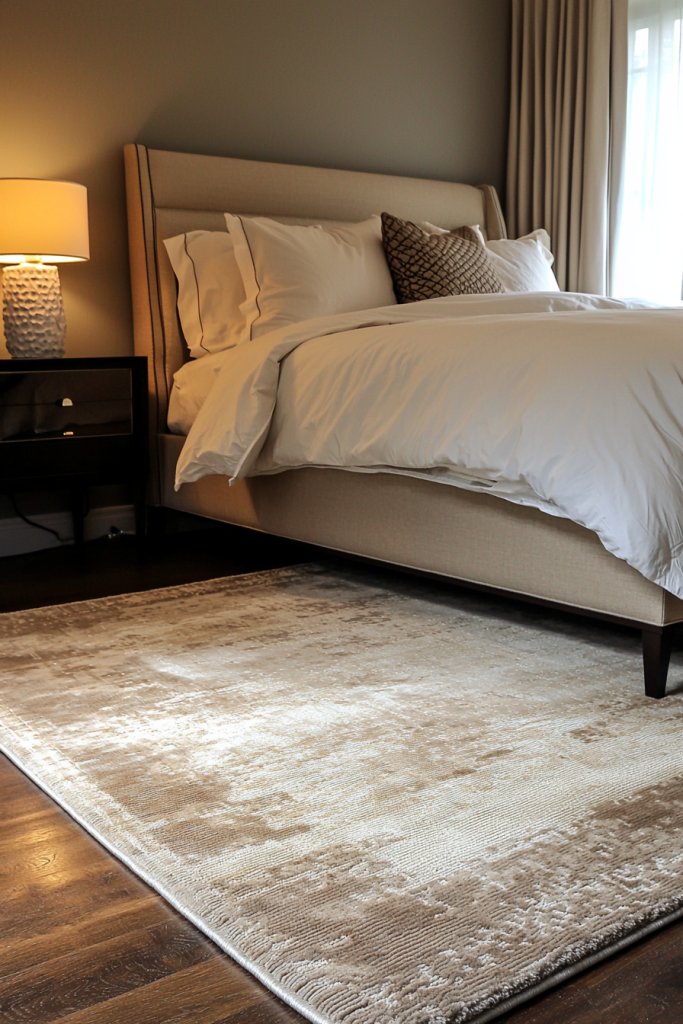
Area rugs are an essential element in bedroom design, helping to define zones, add warmth, and introduce texture and color. A well-placed rug anchors your furniture arrangement and makes the room feel cozy, inviting, and visually cohesive.
Picture a plush, cream-colored shag rug tucked under the bed, extending beyond the sides to create a soft landing zone for your feet. Alternatively, a patterned rug with subtle geometric shapes in muted tones can add visual interest while complementing your decor. Positioning rugs under the bed or seating areas helps delineate different functional zones, especially in larger rooms or open-plan spaces. The tactile experience of a soft rug underfoot enhances comfort and contributes to the room’s overall warmth, both physically and visually.
To implement this, measure your space and select a rug size that fits well—typically, at least 2-3 feet extending beyond the bed on each side. Choose materials based on your lifestyle: wool or synthetic fibers are durable and plush, while jute or flatweave options bring a more casual, natural look. Use a non-slip pad underneath to keep the rug in place and ensure safety. Layer multiple rugs for a more dynamic look or stick with a single statement piece for simplicity. This simple addition instantly elevates your bedroom’s comfort and style while making it feel more cohesive and inviting.
15. Arrange for Optimal Natural Light and Ventilation
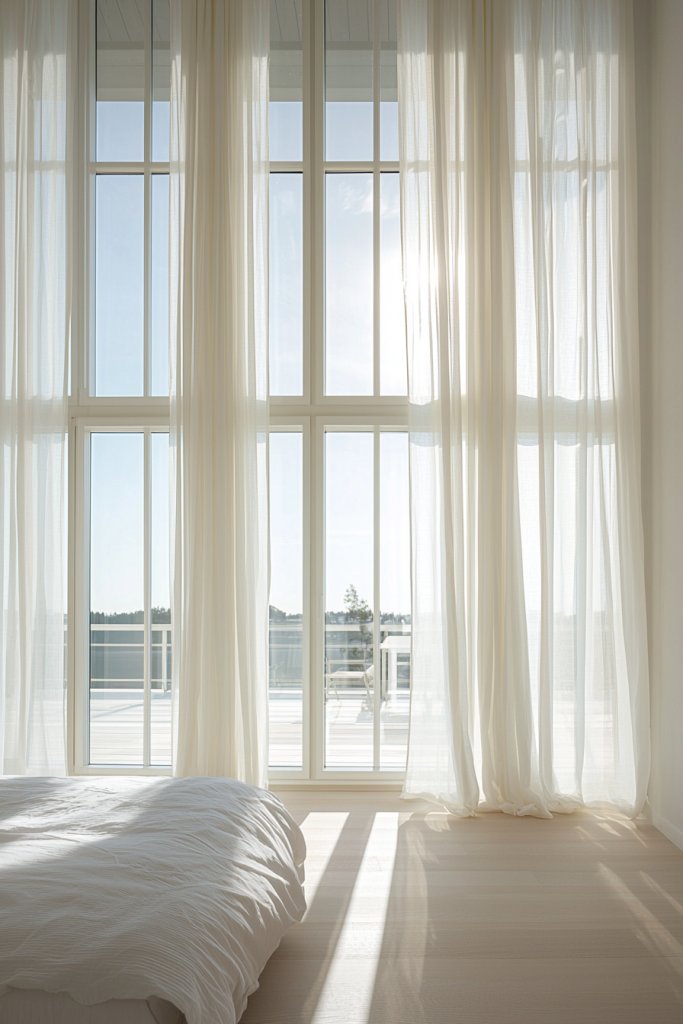
Harnessing natural light and fresh air can transform your bedroom into a bright, airy sanctuary that promotes well-being and relaxation. Properly maximizing sunlight and airflow not only enhances the room’s aesthetic but also improves mood and sleep quality, making it a vital aspect of thoughtful bedroom layout.
Imagine sunlight streaming through large, unobstructed windows, casting warm, golden hues across soft, neutral-colored walls. Light filters softly over a plush, textured rug and a cozy bed dressed in crisp white linens, creating a serene glow. Gentle breezes flow through open windows, moving sheer curtains that flutter slightly, adding a soothing movement and fresh scent to the space. The room feels expansive, vibrant, and invigorating, with an inviting breeze that encourages relaxation and clarity.
To achieve this, position your bed and furniture to avoid blocking windows and allow maximum light penetration. Choose lightweight, airy window treatments like sheer curtains or blinds that can be easily opened during the day. Incorporate cross-ventilation by placing windows on opposite walls or installing a ceiling fan to enhance airflow. Regularly clean and maintain your windows and vents to ensure optimal light and ventilation, creating a refreshing retreat that energizes you each morning.
16. Incorporate Soft, Ambient Colors in Bedding and Decor
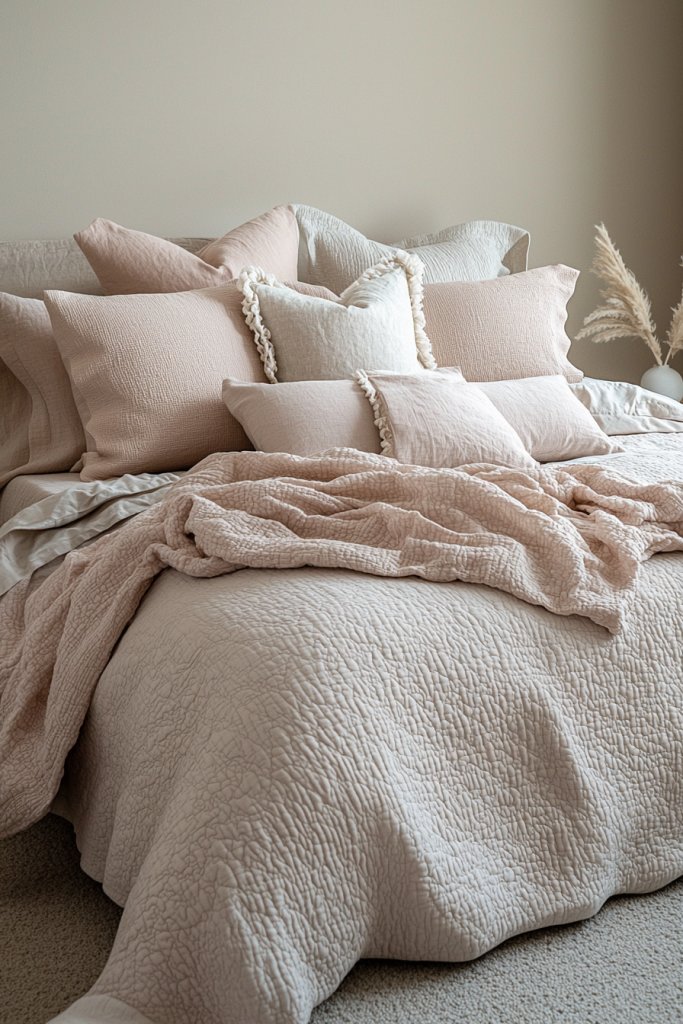
Using soft, ambient colors creates a tranquil environment that promotes relaxation and restful sleep. Pastel shades, muted neutrals, and gentle tones help establish a cohesive, calming aesthetic that feels welcoming and serene.
Visualize a bedroom with a bed dressed in pale blush or light lavender linens, accented by a plush, cream-colored throw blanket with chunky knit textures. Decorative pillows in dusty rose or soft gray add layers of comfort and visual interest, while sheer curtains in a delicate mint hue diffuse natural light softly across the room. The walls are painted in a soothing beige or pale blue, complemented by accessories like ceramic vases, textured cushions, and subtle metallic accents—think brushed gold or matte silver—to add understated elegance. The overall palette feels light, airy, and harmonious, creating a peaceful retreat that invites you to unwind.
To incorporate these colors, start with a neutral base for your walls and larger furniture pieces. Choose bedding and decor items in pastel or muted shades, mixing textures like linen, velvet, and cotton for depth. Keep accessories minimal but thoughtfully chosen to avoid visual clutter. Incorporate scented candles with calming fragrances like lavender or chamomile to enhance the relaxing atmosphere. This approach transforms your bedroom into a soft, ambient haven perfect for unwinding after a busy day.
17. Use Unique Decorative Objects to Add Character
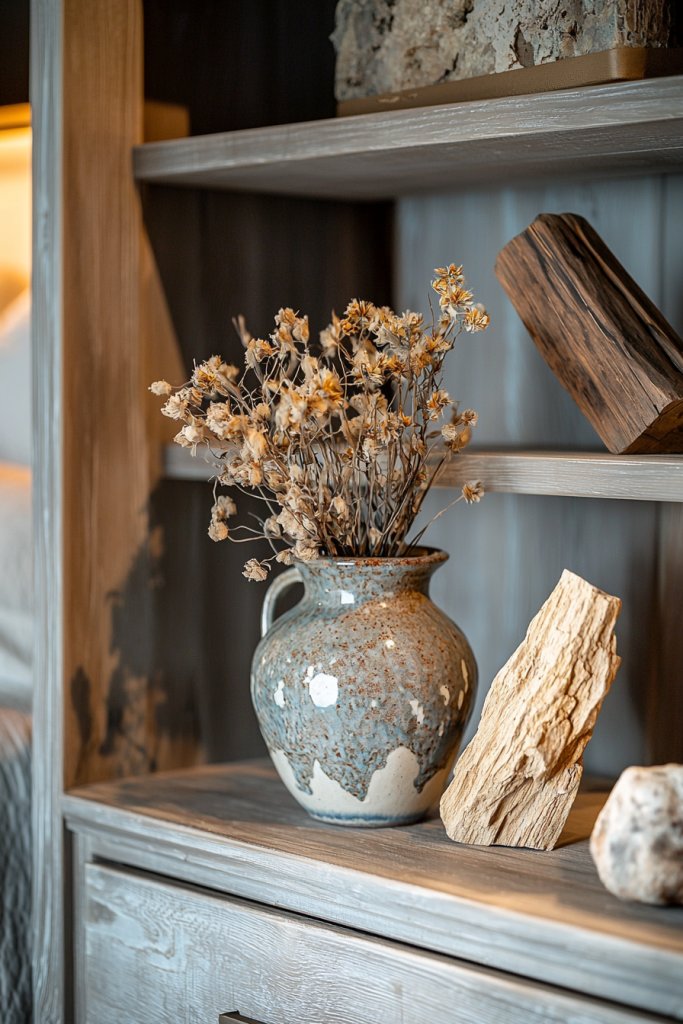
Incorporating distinctive decorative objects gives your bedroom a sense of personality and charm, turning it into a space that reflects your unique style and story. These pieces serve as conversation starters and elevate your overall decor with visual interest and character.
Imagine placing a vintage ceramic vase filled with dried flowers on a side table, or a sculptural sculpture made from natural materials like wood or stone as a centerpiece. A collection of unusual objects—such as antique cameras, decorative trays, or handcrafted ceramics—can be displayed on open shelves or atop dressers, adding layers of texture and intrigue. These items come in varying shapes, colors, and finishes, creating a curated look that feels eclectic yet cohesive. The space gains depth and a sense of curated authenticity, making it more inviting and reflective of your personality.
Start by choosing a few statement objects that resonate with your aesthetic—perhaps a vintage find from a flea market or a piece of handmade art. Mix different materials and styles for an eclectic vibe, or keep it streamlined with a consistent theme. Arrange these objects thoughtfully on surfaces or shelves, ensuring they complement rather than overcrowd the space. Regularly rotate or update your collection to keep your bedroom feeling fresh and infused with your personal touch.
Conclusion
With a diverse array of ideas—from creating focal points and optimizing flow to adding personal touches and maximizing storage—there’s no shortage of ways to transform your bedroom into a comfortable and stylish sanctuary. Experimenting with these layouts can help you craft a space that truly reflects your personality while enhancing everyday comfort. Don’t hesitate to try different combinations to discover what works best for you. Start designing today and turn your bedroom into the perfect retreat you’ve always envisioned!
Leave a Reply